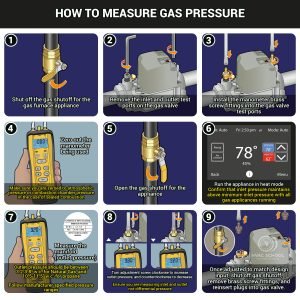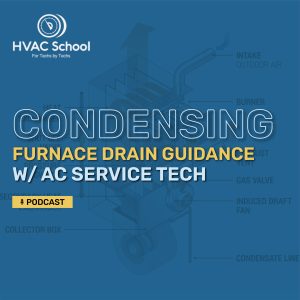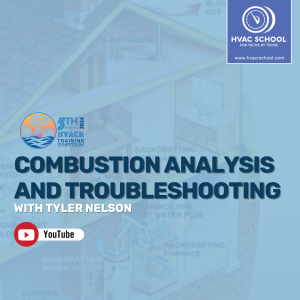BACK
 The Chemistry of Combustion In the Wild
The Chemistry of Combustion In the Wild
 The Heating Sequence of Operations and Onions
The Heating Sequence of Operations and Onions
 How To Do a Heat Maintenance That Actually Matters
How To Do a Heat Maintenance That Actually Matters
 Soft Lockout vs. Hard Lockout
Soft Lockout vs. Hard Lockout
 Troubleshooting 90%+ Gas Furnaces
Troubleshooting 90%+ Gas Furnaces
 Practical Uses of Combustion Analysis
Practical Uses of Combustion Analysis
 The Case for Buying a Combustion Analyzer
The Case for Buying a Combustion Analyzer
 Gas Furnaces – What a Tech Needs to Know
Gas Furnaces – What a Tech Needs to Know
 Gas Furnace Maintenance Procedure
Gas Furnace Maintenance Procedure
 History of Gas Furnaces – Redux
History of Gas Furnaces – Redux
 Heat Exchangers and Temperature Rise – Short #227
Heat Exchangers and Temperature Rise – Short #227
 Condensing Furnace Drain Guidance w/ AC Service Tech
Condensing Furnace Drain Guidance w/ AC Service Tech
 Primary & Secondary Air in Combustion – Short #187
Primary & Secondary Air in Combustion – Short #187
 All About 90% Furnaces
All About 90% Furnaces
 I’ve Got a Combustion Analyzer, What’s Next?
I’ve Got a Combustion Analyzer, What’s Next?
 Combustion Analysis and Troubleshooting
Combustion Analysis and Troubleshooting
 Combustion Analysis: Easier, Faster, and Better
Combustion Analysis: Easier, Faster, and Better
#gas furnace
Tech Tips:

If you’ve been following my writing for the last couple of years, you know that I like to blather on and on about combustion analysis. Now, I am by no means an expert on the subject, as I live in North Texas (which is not known for its intense heating season), but I love using […]
Read more
Just like Shrek, I like to think about the heating sequence of operations as an onion—it has layers. And each layer builds upon the previous one. We have written previously in great detail about gas furnaces, from top to bottom. I want to focus today on why there is a sequence of operations and how […]
Read more
I know I’m not the only one who has sometimes felt a little bad doing heat maintenance. I remember many a day when my lead technician and I (as an apprentice) would crawl into an attic, clean the flame sensor, and then play FarmVille on our phones for 15 minutes before crawling down, giving the […]
Read more
If a furnace runs for years and years while tripping the limit switch but satisfies the thermostat, will it ever be noticed? The answer is most likely “no,” but it will depend on whether the furnace utilizes soft or hard lockouts when the limit switch trips. So, what is a soft lockout vs. a hard […]
Read more
This tech tip recaps the livestream by the same name, featuring HVAC School contributors Matt Bruner and Adam Mufich and special guest Ty Branaman. You can watch that livestream on our YouTube channel HERE and visit Ty’s at https://www.youtube.com/@love2hvac. While 80% gas furnaces are relatively commonplace in the Southeastern United States, where HVAC School is […]
Read more
This tech tip reviews the live stream by the same name aired on November 1st, 2023. You can watch the full live stream HERE. We want to give special thanks to the guests: Jim Bergmann, Jim Davis, Tony Gonzalez, Louise Kellar, Bill Spohn, and Tyler Nelson! Gas furnaces (or any combustion equipment) create a controlled […]
Read more
Last year, I bought my first combustion analyzer. I had just started my own company and felt the additional weight of responsibility to sit down and determine the best way to verify that the furnaces I was servicing were working safely. In the past, the most extensive testing I had done was a visual inspection […]
Read more
It’s that time of year again—the furnace service calls are peaking. It’s a good idea to crack open Jason Obrzut’s book, Gas Heating: Furnaces, Boilers, Controls, Components, and listen to the many public podcasts and presentations by experts like Jim Bergmann. At HVAC School, we’re fortunate to have had some of the industry’s greatest minds […]
Read more
This gas furnace maintenance procedure in this article was developed by Michael Housh. Michael is the owner of Housh Home Energy in Ohio. He regularly works on natural gas equipment and is an active contributor to the HVAC School Facebook group. Thanks, Michael! Gas-fired equipment has a different set of components than your typical straight-cool […]
Read moreVideos:
Podcasts:

Jim takes us all the way through the history of furnaces, from the Stone Age when he was a child to modern modulating condensing types. The goal of a furnace is to move heat, so a furnace uses heat exchangers to facilitate heat transfer. Furnaces have primary and secondary air. The primary air goes […]
Read more
In this short podcast episode, Bryan talks about heat exchangers and temperature rise in gas furnaces, especially 80% open-combustion gas furnaces. Temperature rise is the difference between the return air temperature and supply air temperature; in cooling, we usually refer to this difference as a delta T or temperature split. The manufacturer sets a […]
Read more
Bryan and Craig Migliaccio (AC Service Tech)dive deep into the complexities of managing condensate drainage in high-efficiency (90%+) gas furnaces. The conversation begins with a clear explanation of why these furnaces produce condensate in the first place – they have two heat exchangers that extract so much heat from the combustion gases that water […]
Read more
In this short podcast, Bryan dives into a gas heating topic: primary & secondary air in combustion. Primary air is the air and oxygen content that enters the furnace BEFORE combustion. In older furnaces, prior to induced combustion, air was drawn in through the front. These older furnaces had adjustable shutters that we could […]
Read more
Bryan Orr hosted a live podcast discussion all about 90% efficient furnaces with HVAC professionals Ty Branaman, Adam Mufich, and Matthew Bruner. They covered the basics of how 90% furnaces work compared to traditional 80% furnaces, troubleshooting tips, and best practices for installation and service. A key difference with 90% furnaces is the addition […]
Read moreEvents:

NOTE: If you cannot view the recording, the video may still be processing. The maximum wait time is 24 hours. We apologize for the delay and appreciate your patience.
Read more
NOTE: If you cannot view the recording, the video may still be processing. The maximum wait time is 24 hours. We apologize for the delay and appreciate your patience.
Read more
NOTE: If you cannot view the recording, the video may still be processing. The maximum wait time is 24 hours. We apologize for the delay and appreciate your patience.
Read more











